I’ve made a video to demonstrate a simple way to ask your dog how he/she likes to be patted. It’s as simple as starting to pat your dog and then stopping and noting the response. https://www.youtube.com/watch?v=jU4TKzBOzw4
Here’s a quick summary of how dogs say “yes” or “no”. Sometimes they say “maybe”. I suspect they are conflicted at times because they want our attention but don’t like the type of attention they are getting. It’s the classic walk away and then come back and then walk away routine. I've heard many times, "Well if he didn't like it, why does he keep coming back?" Once we change our approach, a “maybe” can soon become a “yes”. Be aware that all dog body language needs to be observed with consideration of the context within which it occurs, the rest of the dog’s body language (not just one part of the dog) and the individual dog involved. Just like people, different dogs have little idiosyncrasies and styles of communicating.
Body language that says “Yes”:
- Moving into your space, coming to you for physical contact
- Nudging a head into your hand or lap
- Pawing your hand, trying to move it closer
- Leaning into you
- Lying down near you, touching you or flopping onto you
- Face, mouth and eyes are relaxed, even droopy
Body language that says “No”:
- Moving away from you, especially if they don’t return or leave the area - This is so important to take notice of. If a dog does not come to you, do not go to the dog and invade the dog's space, especially if you do not know the dog. Do not put dogs in situations where they cannot move away or escape from a patting interaction you think is pleasant but they don't appreciate
- Leaning away from you.
- Turning the head away
- Looking away from you with the eyes
- Shying away or ducking the head away from your hand
- Rolling the eyes away to show the whites of the eye (whale eye)
- Yawning
- Licking the lips
- Freezing (a tense stillness as opposed to a relaxed stillness)
- Growling
- Snapping
- Biting
Body language that could mean “Yes” or “No”:
- Licking your face or hands. This can be asking for space or for you to stop. It is a common appeasement signal. Appeasement behaviours function to reduce or get rid of some part of the interaction which they do not like without using overt aggression. It can also be a sign of affection from a very mouthy, licky dog.
- Rolling over. If the dog is tense, lips are drawn back and tense, this means "no". It is another appeasement behaviour. If the dog is floppy and the eyes are soft or closed, this means “rub mah belly”. Refer to the pictures below.
* Ears pinned back (one forward due to pressure of couch)
* Tight mouth, pulled back at commissure
* Front paws tucked tight, not relaxed
* Quick lick lip
* Back legs rolling partially open but tense
* Mouth relaxed (floppy gums dropping with gravity, exposing teeth)
* Front legs floppy and relaxed
* Back legs relaxed, flopping wide open with gravity
* Skin around eyes soft, not taut
* Body relaxed, stretched out fully, lying fully on back
- Paw raised. If the dog is tense and the body is leaning away, it means “no”. If the dog is leaning towards you and body is relaxed, it can be “yes” or "maybe".
- Walking away. Some dogs will walk away and come back. They may want attention from you, but not the sort you are giving. If you change what you are doing, they may stay.
- Mouthing the hand. This may mean “no” if it occurs whilst you are petting and stops when you stop. Some dogs show affection by mouthing, so they may gently mouth your hand as you pat them. If it occurs when you stop petting, it could be a mouthy dog requesting for you to continue. In the video, Turbo mouths when the patting stops to get it to start again. He stops mouthing when the person is patting him. When it happens it very important. Does the dog mouth to stop you, or to get you to start again?
- Being motionless. If the dog is relaxed and motionless they may be enjoying the pat. They may lean ever so slightly into your touch, with all the other signs of enjoyment (soft eyes, ears, mouth). If they have “frozen” and are tense or rigid under your touch, almost resisting relaxation or holding their breath, they are probably not enjoying the patting and are waiting for it to stop. You can often feel a pounding heart under the chest of a dog who is very still but not enjoying the contact.
- Lots of wiggling. Some dogs are happy, wiggly, bouncy balls of exuberance who can’t stop moving when they are enjoying an activity. Others are nervous, uncomfortable wigglers who are torn between wanting some attention from you but not liking where or how they are being touched.
I'm encouraged by the comments I’ve read on social media. Many people notice a difference in the way their dog approaches, stays and responds to them when they take the time to observe, ask the dog and accommodate what he/she enjoys.
Have a try. Ask your dog and let me know the answer.
Want to practice more observations skills? Read this other great blog and video on the same topic:
http://eileenanddogs.com/2012/08/29/does-your-dog-really-want-to-be-petted/
Here are some great resources which Eileenanddogs.com recommends in her blog. She is spot on with her recommendations, so with her permission, I've included them just as she has recommended. You can never get enough of the good stuff. Go check out her blog.
Recommended Resources:
"Doggonesafe.com: How to Love Your Dog – Believe it or Not. This little gem describes ways to ask the dog’s consent, encourages getting to know one’s dog’s language, and suggests ways that humans and dogs can be physically close to each other without intimidating or “over-touching” the dog. The whole website has great stuff about learning to read dogs and keeping kids safe around them.
Dogs Like Kids They Feel Safe With. This is a wonderful movie about teaching dogs with a clicker and teaching children with TAGteach with the goal of comfortable and safe interaction between the two. Children who are fearful and and children who tend to overdo with animals are both included. The children are taught about asking the adult handler’s and the dog’s consent.
Dr. Sophia Yin has a wealth of information on dog body language, polite greeting behavior (from humans), and low stress handling. Here is a page with a load of information. Free Downloads: Posters, Handouts, and More.
Family Paws is another great site that focuses on safe interactions between dogs and their human family members, with special emphasis on education for expecting families and families with infants. Here is founder Jennifer Shryock doing a great analysis of a now infamous human/dog petting session gone wrong, with nice explanations of the mismatch between dog and human communication and expectations.
Observation Skills for Training Dogs. That great FaceBook group I have mentioned before."
© Sonya Bevan
Dogcharming.com.au
Thank you to Eileen Anderson for sharing her blog and resource recommendations, Steph Walker for her pictures of Reggie and Bodel Mitchell for sharing Zoe with me.

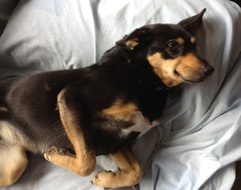
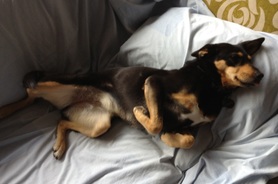
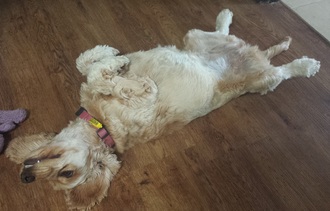
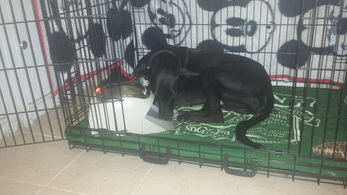
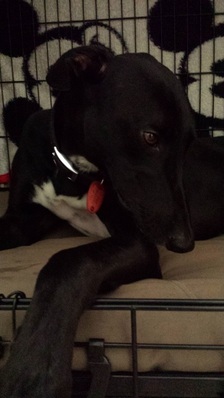
 RSS Feed
RSS Feed